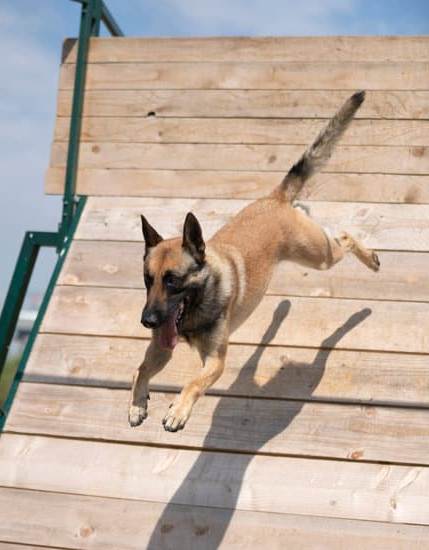Disassociative states, also known as dissociation, are a complex and often misunderstood phenomenon that can greatly impact individuals’ lives. These states involve a detachment from reality and can manifest in various forms, including dissociative amnesia, depersonalization disorder, and dissociative identity disorder (DID). For those affected by disassociative states, navigating daily life can be challenging and overwhelming.
In recent years, the use of service dogs has gained recognition as a valuable resource for individuals with disabilities. These highly trained animals assist their handlers in performing tasks and navigating challenging situations. While commonly associated with physical disabilities or psychiatric conditions like anxiety or PTSD, service dogs may also have the potential to recognize disassociative states.
This article aims to explore the possibility of training service dogs to recognize different forms of disassociative states. By understanding the role of service dogs in assisting individuals with disabilities and exploring different training methods, we can evaluate whether these remarkable animals possess the ability to identify and respond to disassociative episodes effectively.
Through real-life case studies and legal considerations surrounding service dog handlers’ rights and responsibilities during disassociative episodes, we will delve into the benefits and possibilities of utilizing service dogs for individuals experiencing these states.
Defining Disassociative States
Disassociative states refer to temporary disruptions in an individual’s memory, consciousness, identity, or perception of their environment. These states can vary in intensity and duration, ranging from mild dissociation to more severe dissociative disorders such as dissociative amnesia, dissociative fugue, and dissociative identity disorder (DID). It is crucial to understand the different forms and symptoms of disassociative states in order to appreciate the potential role of service dogs in recognizing and assisting individuals experiencing these conditions.
One form of disassociative state is dissociative amnesia. This condition involves a sudden inability to recall important personal information or events that are typically too extensive to be explained by ordinary forgetfulness. Dissociative amnesia often occurs in response to traumatic experiences and can result in gaps in an individual’s memory for personal history or periods of time.
Another form is dissociative fugue, where a person suddenly and unexpectedly travels away from their home or work, often assuming a new identity. During a fugue state, an individual may appear confused or lost and might not remember their previous life or circumstances.
Perhaps one of the most well-known forms of disassociative state is DID, previously known as multiple personality disorder. Individuals with DID have distinct identities or personality states that recurrently take control of their behavior and consciousness. The presence of two or more distinct personality states distinguishes DID from other mental health conditions. Each alter (alternate identity) may have its own unique characteristics, memories, traits, and mannerisms.
The symptoms associated with disassociative states can be highly distressing for individuals experiencing them. Some common symptoms include confusion about one’s identity or surroundings, memory loss for specific periods of time or events, feeling detached from one’s body (depersonalization), feeling like the world is unreal (derealization), and experiencing gaps in memory or consciousness. It is crucial to identify and understand these symptoms in order to provide appropriate support and assistance to individuals with disassociative states.
The Role of Service Dogs in Assisting Individuals with Disabilities
Service dogs play a crucial role in assisting individuals with disabilities, including those who experience disassociative states. These highly trained and skilled animals provide invaluable support and companionship to their handlers, helping them navigate daily life and manage their conditions more effectively.
One of the main roles of service dogs is to provide physical assistance to individuals with disabilities. This can include tasks such as retrieving objects, opening doors, or turning lights on and off.
For individuals experiencing disassociative states, service dogs can be trained to provide grounding techniques or tactile stimulation to help the person stay present and connected during an episode. By nudging or pawing at their handler, a service dog can redirect their attention and bring them back into the present moment.
In addition to physical assistance, service dogs also offer emotional support to individuals with disabilities. They are trained to recognize signs of distress or anxiety in their handlers and provide comfort and reassurance through gentle touch and affection. This is particularly beneficial for individuals experiencing disassociative states, as the presence of a calm and supporting animal can help reduce feelings of fear or panic during an episode.
One study conducted by researchers at Purdue University found that service dogs were effective in reducing symptoms of post-traumatic stress disorder (PTSD) among veterans, which often includes disassociative states. The study showed that having a service dog resulted in lower levels of anxiety, depression, and other PTSD symptoms among participants.
Overall, service dogs play a vital role in assisting individuals with disabilities, including those who experience disassociative states. Their ability to provide both physical assistance and emotional support greatly enhances the quality of life for their handlers. Through specialized training techniques that focus on recognizing and responding to disassociative states, these remarkable animals are able to positively impact the lives of those they serve.
| Role of Service Dogs | Data |
|---|---|
| Physical assistance provided | Retrieving objects, opening doors, turning lights on and off |
| Emotional support offered | Comforting touch, affection, recognition of distress |
| Impact on PTSD symptoms | Lower levels of anxiety, depression, and other symptoms found in a study at Purdue University |
The Basics of Service Dog Training
Service dog training is a comprehensive process that involves developing a wide range of skills and abilities in order to effectively assist individuals with disabilities. These highly trained animals are able to perform specific tasks that aid their handlers in overcoming daily challenges. In the context of recognizing and responding to disassociative states, service dogs must undergo specialized training to acquire the necessary skills.
One of the fundamental skills required for service dogs is obedience training. This includes commands such as sitting, staying, coming when called, and walking obediently on a leash. Obedience training instills discipline and ensures that service dogs can respond appropriately to their handler’s instructions even in distracting or stressful situations. A well-behaved service dog is crucial for safely navigating public spaces and providing assistance when needed.
In addition to obedience training, service dogs must also be trained in task-specific skills that directly address the needs of individuals experiencing disassociative states. For example, they may be taught to recognize certain physical or behavioral cues exhibited by their handler during a disassociative episode. This may involve alerting the individual or those around them, applying deep pressure therapy as a grounding technique, or retrieving medication or comfort objects.
Throughout the training process, it is important for service dogs to build a strong bond with their handlers. This bond not only enhances communication and teamwork but also increases the dog’s ability to anticipate their handler’s needs and provide assistance before crisis situations escalate. Handlers often rely on their service dogs as an emotional support system during disassociative episodes, so it is crucial for the animal to be attuned to its handler’s emotional state.
Overall, service dog training requires a combination of obedience skills and task-specific abilities to effectively assist individuals experiencing disassociative states. Through proper training techniques and consistent reinforcement, these remarkable animals are able to provide valuable support and improve the quality of life for their handlers.
Evaluating the Possibility
Disassociative states can be distressing and debilitating for individuals who experience them. These states, characterized by a detachment from reality or one’s own sense of identity, can leave individuals feeling disoriented and vulnerable. The need for assistance in managing disassociative states has led to the exploration of service dogs as potential aids in recognizing and responding to these episodes.
While service dogs are known for their ability to assist individuals with physical disabilities, their potential to recognize and respond to mental health conditions is less commonly explored. However, there have been anecdotal reports and case studies suggesting that service dogs may indeed be capable of detecting and alerting their handlers to disassociative states.
One possible explanation for this capability is that service dogs have an acute sense of smell, which allows them to pick up on changes in their handler’s scent or body odor that may occur during a disassociative state. Additionally, they have been trained to closely observe their handlers’ behavior and body language.
By learning to recognize subtle cues that indicate the onset of a disassociative episode, service dogs may be able to provide valuable assistance by alerting their handler or guiding them away from potentially dangerous situations.
To evaluate the possibility of service dogs truly recognizing disassociative states, further research is needed. Controlled studies could be conducted to observe whether service dogs consistently respond differently during disassociative episodes compared to normal functioning periods. This would involve monitoring the dog’s behavior and physiological responses while interacting with its handler during various scenarios.
Case Studies
In order to fully understand the potential for service dogs to recognize and respond to disassociative states, it is important to explore real-life examples of these animals in action. There have been numerous cases where service dogs have demonstrated their ability to recognize and respond appropriately when their handler is experiencing a disassociative state.
Case Study 1: Bella
One notable case involved a service dog named Bella and her handler, Sarah. Sarah had been diagnosed with dissociative identity disorder (DID) and often experienced sudden shifts in her consciousness. Through specialized training, Bella was able to identify certain behavioral cues from Sarah that indicated she was entering a disassociative state. When Bella recognized these cues, she would immediately alert Sarah by gently nuzzling or licking her hand, bringing her back into the present moment and preventing potentially dangerous situations.
Case Study 2: Max
Another example involved a service dog named Max and his handler, Jake. Jake suffered from post-traumatic stress disorder (PTSD) and frequently experienced disassociative episodes triggered by traumatic memories. During these episodes, Jake would become disconnected from reality and find it difficult to ground himself.
Max was trained to sense changes in Jake’s breathing patterns and heart rate, which often indicated the onset of a disassociative state. In response, Max would apply deep pressure therapy by leaning against Jake’s body or pressing against him with his paws, helping him feel more grounded and reducing the severity of the episode.
Case Study 3: Lucy
Lucy is another service dog who has proven her ability to recognize disassociative states in her handler, Emily. Emily has epilepsy with partial complex seizures that sometimes cause her mind to disconnect from reality for short periods of time.
Lucy underwent intensive training to learn how to detect changes in Emily’s body odor and behavior that occurred prior to the onset of a disassociative state. When Lucy senses these changes, she can alert Emily or others around her by nudging them or barking, ensuring they are aware of the imminent seizure and can take necessary precautions.
These case studies demonstrate the incredible potential that service dogs have in recognizing and responding to disassociative states. Through their specialized training and keen sense of observation, these animals can provide invaluable support and assistance to individuals experiencing these conditions. While every case is unique, the success stories of Bella, Max, Lucy, and many other service dogs only further highlight the immense benefits that can come from the partnership between humans and their canine companions.
By sharing these real-life examples, we not only offer hope to those who may be considering a service dog as a form of support for their disassociative states but also underscore the importance of continued research and development in this field. With further exploration into training methods and identification techniques, service dogs have the potential to become even more effective at recognizing and assisting with disassociative states in individuals with disabilities.
Training Methods
When it comes to training service dogs to recognize and respond to dissociative states, there are several techniques that can be employed. These methods focus on teaching the dogs to detect specific cues and behaviors exhibited by individuals experiencing disassociative states. By understanding these techniques, trainers can effectively teach service dogs to identify and respond appropriately in order to provide assistance and support.
One common technique used in training service dogs to recognize disassociative states is scent detection. Dogs have a highly developed sense of smell, which allows them to detect changes in an individual’s body odor or scent when they are experiencing a disassociative state.
Trainers can introduce specific scents associated with disassociative states during the dog’s training process, gradually teaching them to associate these scents with the state. Through repetition and positive reinforcement, the dog learns to alert their handler when they detect the scent, which signals that the individual is entering a disassociative state.
Another technique used in training is behavior recognition. Trainers work closely with individuals experiencing disassociative states to identify specific behaviors or physical cues that occur before or during an episode. For example, the person may exhibit increased heart rate, rapid breathing, or repetitive movements.
Trainers then teach the service dog how to recognize these behaviors and respond accordingly. This may involve actions such as pawing at their handler for attention or retrieving a specified object that provides comfort or grounding for the individual.
A combination of positive reinforcement and desensitization techniques is often utilized during training. Positive reinforcement involves rewarding the dog with treats, praise, or playtime when they correctly identify and respond to disassociative states. This reinforces their understanding of what is expected from them and encourages them to continue exhibiting the desired behavior.
Desensitization involves gradually exposing the dog to different scenarios related to disassociative states, allowing them to become familiar and comfortable with these situations. This reduces the likelihood of the dog becoming anxious or overwhelmed when encountering a real-life disassociative state.
Overall, training service dogs to identify disassociative states involves a combination of techniques that leverage the dog’s natural abilities and instincts. These methods aim to create a strong bond between the dog and their handler, enabling them to work together effectively as a team in recognizing and responding to disassociative states. Through consistent training and ongoing reinforcement, service dogs can play a vital role in providing support and assistance to individuals experiencing these conditions.
| Technique | Description |
|---|---|
| Scent Detection | Teaching dogs to recognize specific scents associated with disassociative states. |
| Behavior Recognition | Training dogs to identify specific behaviors or physical cues exhibited by individuals during disassociative states. |
| Positive Reinforcement | Rewarding dogs for correctly identifying and responding to disassociative states. |
| Desensitization | Gradually exposing dogs to different scenarios related to disassociative states to reduce anxiety or overwhelm. |
Implementing Training
Training a service dog to recognize and respond to disassociative states requires careful planning and consistent implementation. It is important to note that not all service dogs are suitable for this specific task, as it requires a unique set of skills and abilities. However, for those dogs that do possess the necessary qualities, there are several effective training methods that can be utilized.
One commonly used technique is scent training, where the dog is taught to associate a particular scent with the onset of a disassociative state. This can be achieved by collecting a small sample of the individual’s scent during an episode and presenting it to the dog during training sessions. Through repetition and positive reinforcement, the dog learns to recognize and respond to this scent when it is detected in future instances.
Another method involves teaching the dog to observe and monitor specific behavioral cues exhibited by their handler during a disassociative state. This may include changes in body posture, breathing patterns, or facial expressions. By reinforcing the dog’s natural ability to be attentive and responsive to their handler’s nonverbal communication, they can learn to identify these cues as indicators of a disassociative state.
Once the dog has successfully learned to recognize disassociative states through these techniques, it is crucial to reinforce their response behavior through ongoing training and practice scenarios. This could involve incorporating simulated disassociative episodes into training sessions or engaging in real-life situations where the individual may experience these states. Consistency and reinforcement are key factors in ensuring that the service dog continues to accurately identify and respond appropriately.
Implementing training for service dogs to recognize disassociative states requires patience, dedication, and expertise from both trainers and handlers alike. It is important for individuals seeking assistance dogs for this purpose to work with qualified trainers who have experience in this specific area of training. With proper implementation and ongoing support, service dogs can play an invaluable role in assisting individuals experiencing disassociative states by alerting them or providing comfort until the episode subsides.
Legal Considerations
Service dogs play a crucial role in assisting individuals with disabilities, including those experiencing disassociative states. However, it is important for service dog handlers to understand their rights and responsibilities when it comes to navigating legal considerations related to disassociative states.
Rights and Protections under the Law
In many countries, individuals with disabilities have legal protections that allow them to use service dogs as a means of accommodation. For example, in the United States, the Americans with Disabilities Act (ADA) provides clear guidelines on service dog usage. According to the ADA, individuals with disabilities have the right to be accompanied by their service dogs in all public places, including establishments where animals are generally not allowed. This includes places such as restaurants, hotels, and malls.
It is important for service dog handlers to understand that they have the right to bring their service dog into these spaces without being denied entry or facing discrimination. It is illegal for businesses or establishments to ask about an individual’s disability or require proof of certification or training for their service dog. As long as the handler can answer two questions affirmatively – “Is this a service animal required because of a disability?”
and “What work or task has the animal been trained to perform?” – they are protected by law.
Responsibilities of Service Dog Handlers
While there are legal protections in place for individuals with disabilities and their service dogs, handlers also have certain responsibilities they must adhere to. These responsibilities include ensuring that their service dog is well-behaved, properly trained, and under control at all times.
Handlers should also be mindful of their role in educating others about disassociative states and informing them about appropriate behavior around their service dog. They may need to advocate for themselves and educate others about the tasks their service dog performs during disassociative episodes.
Furthermore, service dog handlers must ensure that their dog is properly cared for and receives necessary veterinary care. Regular training sessions should also be conducted to reinforce the recognition and response skills related to disassociative states.
By understanding both their rights and responsibilities, service dog handlers can confidently navigate legal considerations and make the most of their partnership with their highly trained assistance animal in managing disassociative states.
The Benefits of a Service Dog
Improved Emotional Support
One of the primary benefits of having a service dog for individuals experiencing disassociative states is the improved emotional support they provide. Disassociative states can often lead to feelings of isolation, fear, and anxiety.
However, having a well-trained and reliable service dog by their side can help individuals feel more grounded and secure in their environment. The presence of a service dog can offer a sense of companionship and unconditional love, which can be incredibly comforting during episodes of disassociation.
Service dogs are known to have a calming effect on their handlers, as they are trained to identify signs of distress and provide immediate assistance. They can use specific cues or trained behaviors to redirect their handler’s attention and help them regain focus during a disassociative episode. The constant companionship provided by a service dog also helps prevent feelings of loneliness that often accompany disassociation, as individuals know they have someone with them who understands their needs.
Promoting Independence and Freedom
In addition to the emotional support they offer, service dogs also promote independence and freedom for individuals experiencing disassociative states. These conditions can greatly impact an individual’s ability to carry out day-to-day activities or participate in social settings. However, with the assistance of a trained service dog, many tasks become more manageable.
For example, if an individual experiences disassociation while out in public, their service dog can be trained to recognize the signs and guide them safely out of crowded areas or back home. This level of support allows individuals with disassociative states to have more confidence in navigating unfamiliar environments without relying heavily on others for assistance.
Increased Safety and Security
Another crucial benefit of having a service dog for those experiencing disassociative states is increased safety and security. Disassociation episodes can make individuals vulnerable as they may lose awareness of their surroundings or become unable to respond effectively to their environment. Service dogs can be trained to act as a safeguard in these situations.
Service dogs can alert others if their handler is in distress, retrieve medication or provide physical stability during disassociation episodes, and even guide their handlers to a safe space. For example, if an individual with disassociative states experiences a blackout episode, their service dog can be trained to lead them away from potential dangers such as crossing streets or approaching hazardous areas.
This level of assistance not only helps prevent accidents but also provides individuals with a sense of security and reassurance in managing their condition.
Overall, the benefits of having a service dog for individuals experiencing disassociative states are significant. They offer improved emotional support, promote independence and freedom, and increase safety and security. Through proper training and support, service dogs have proven to be invaluable companions for those with disassociative states, providing comfort and assistance during times when they need it most.
Conclusion
In conclusion, the potential of service dogs in recognizing and assisting with dissociative states is promising. Through the exploration of different forms and symptoms of dissociative states, it becomes evident that individuals with disabilities could greatly benefit from the support and companionship of a well-trained service dog. These remarkable animals possess the skills and abilities required to recognize and respond to dissociative states, as demonstrated by real-life case studies.
The training methods used to teach service dogs to identify dissociative states are diverse and effective. Through positive reinforcement techniques and rigorous training programs, these dogs can be taught to detect subtle changes in their handlers’ behavior or demeanor that indicate a dissociative state. This enables them to promptly intervene and provide comfort or assistance, ensuring the safety and well-being of their handler.
Implementing training for service dogs to recognize dissociative states requires patience, dedication, and expertise. Handlers must work closely with professional trainers who specialize in this specific area, ensuring that their service dog receives proper guidance and instruction. Legal considerations regarding the rights and responsibilities of service dog handlers in relation to dissociative states must also be taken into account.
Overall, the benefits of a service dog for individuals experiencing dissociative states cannot be overstated. These incredible animals provide not only physical assistance but also emotional support and companionship. Their ability to detect and respond to dissociative episodes is truly remarkable, offering individuals with disabilities a sense of security and independence they may not have otherwise experienced.
Frequently Asked Questions
Can you have a service dog for dissociative identity disorder?
Dissociative Identity Disorder (DID) is a complex mental health condition, also known as multiple personality disorder. While service dogs are commonly used to assist individuals with various disabilities, there is limited research and evidence specifically addressing the use of service dogs for people with DID. Service dogs are typically trained to perform tasks that mitigate the effects of a person’s disability, such as guiding individuals who are visually impaired or alerting those with epilepsy to an impending seizure.
Since the symptoms of DID can be unique to each individual and their specific alters, it may be challenging to train a service dog to perform specific tasks related to dissociation. However, it is possible that some individuals with DID may find comfort, emotional support, and stability in having a well-trained canine companion.
Can service dogs help with depersonalization?
Depersonalization is a dissociative symptom characterized by feeling detached from one’s thoughts, feelings, body, or surroundings. While service dogs aren’t specifically trained for depersonalization alone, they can still offer support and benefits for individuals experiencing this symptom.
Dogs naturally provide companionship and emotional support, which can help reduce feelings of isolation and detachment associated with depersonalization. The presence of a service dog can promote grounding techniques by redirecting attention towards the dog’s needs and routines, potentially aiding in reconnection with reality.
Can service dogs help with psychosis?
Psychosis refers to a mental state where an individual experiences hallucinations, delusions, or a loss of touch with reality. Service dogs are not primarily trained or recognized as interventions for treating psychosis directly; however, they can contribute indirectly to the well-being of individuals living with psychosis. People experiencing psychosis often face social isolation due to stigmatizing attitudes and misconceptions surrounding their condition.
A service dog’s presence can provide companionship while reducing feelings of loneliness or alienation among individuals struggling with psychosis. Although further research is needed regarding the specific impacts on psychosis management, having a well-trained service dog might provide emotional support and a sense of stability, thereby potentially contributing to overall mental well-being.

Welcome to the blog! I am a professional dog trainer and have been working with dogs for many years. In this blog, I will be discussing various topics related to dog training, including tips, tricks, and advice. I hope you find this information helpful and informative. Thanks for reading!





